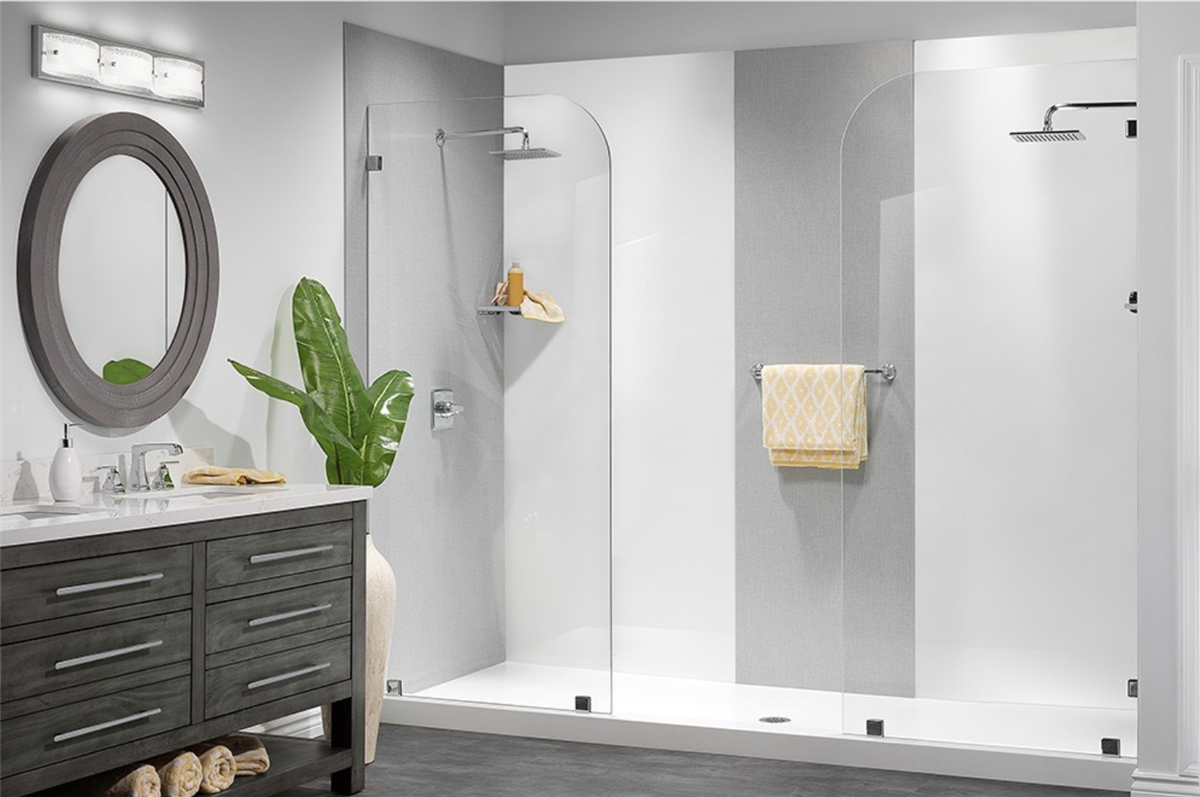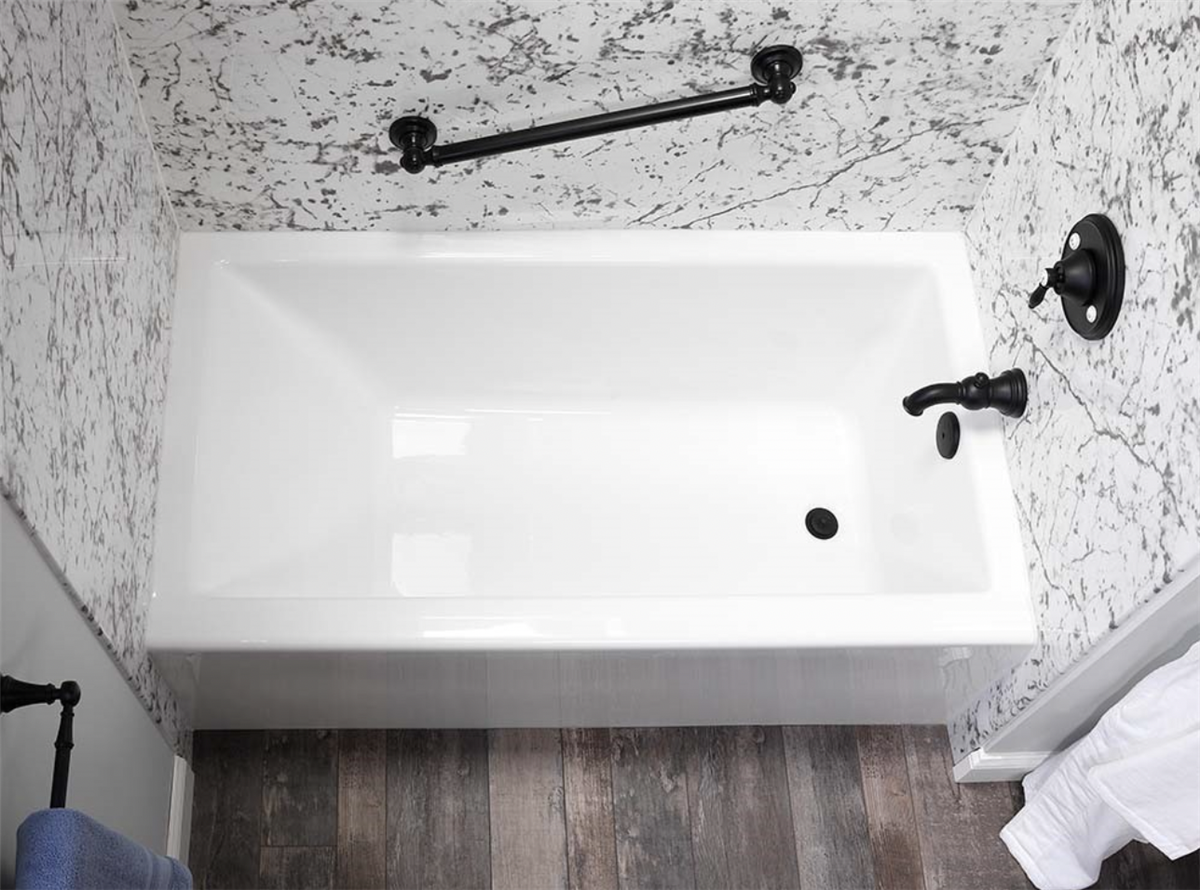You know you’re ready for a shower remodel. You just don’t know what materials to use. Frankly, the wrong material could throw off everything from your budget to your interior design to your projected ROI.
The good news? Walk in shower materials are our bread and butter. Having completed thousands of shower remodels, ZINTEX Remodeling offers unparalleled expertise on acrylic shower walls–and on the materials we don’t use, like tile and solid surface.
Ready to get one step closer to breaking ground on your shower remodel? Read on to learn how acrylic shower walls stack up against other popular materials.
What Are the Main Shower Wall Materials Used in Shower Remodels?
First, let’s answer the most pressing question you have at this point: what are your options? You already know that this guide will teach you more about acrylic panels, which you may sometimes see referred to as high-tech polymer (a more technical description of what acrylic wall panels are made of). Acrylic is becoming a top contender in shower and bath remodels thanks to factors like cost, maintenance, and more.
This guide will also cover two of the time-tested shower wall materials you’re bound to discover on your shower remodel journey:
- Tile
- Solid surface (e.g., marble, quartz, and granite)
While tile runs the gamut from budget to high-end, you’ll typically see solid surface in luxury bathrooms thanks to its sophisticated appearance and higher price point.
What Is the Cost of Walk In Shower Materials?
In a bathroom remodel, materials alone are going to take up around 40-60% of your budget. It’s no wonder that cost is first on just about everyone’s mind when deciding which materials to use in a walk in shower remodel.
| Acrylic | Tile | Solid Surface |
|---|---|---|
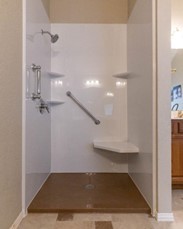 | 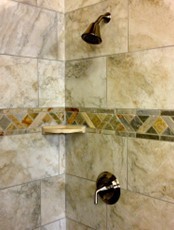 | 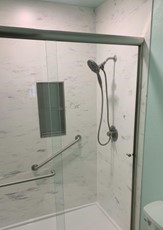 |
| Materials | Cost Range |
|---|---|
| Acrylic | $8,000 - $15,000 |
| Tile | $4,000 - $20,000 |
| Solid surface | $10,000 - $17,000 |
If you’re looking for a budget-friendly material to use, the winner is acrylic. That said, using acrylic won’t inherently make your shower remodel cheaper. It’s all about the style, brand, and quality of your materials.
How Long Do Different Shower Materials Take to Install?
Next up is time. Even a simple shower remodel can feel intrusive, especially when you aren’t sure how long it will take before your install team leaves and peace is restored to your home.
| Materials | Average Install Timeline |
|---|---|
| Acrylic | 1-2 days |
| Tile | 3-7 days |
| Solid surface | 1-2 days |
If you’re looking for a quick turnover, acrylic and solid surface are pretty much tied. This is because each wall panel is one solid piece, unlike tile, which must be installed piecemeal and in a precise pattern.
Keep in mind that install time is not the same as your overall timeline, which will include time to plan your remodel and prepare your space. The early stages may take several days regardless of the material you use, especially if you need significant changes or upgrades to your plumbing.
What Are Your Design Options Using Different Shower Materials?
With a few of the practical considerations out of the way, what about design? Each of these three shower materials does allow for some design versatility, but to varying degrees.
| Materials | Design Pros | Design Cons |
|---|---|---|
| Acrylic | ✅Comes in an increasing array of designs and colors ✅High-end acrylic can mimic tile and natural stone | ❌Fewer design options than tile ❌Not as luxurious as natural stone |
| Tile | ✅Offers the most variety in terms of colors, textures, and materials (such as ceramic or limestone) ✅Can be grouted in different patterns for different overall effects | ❌Install time and price tend to go up with more intricate designs ❌Grout is unavoidable |
| Solid surface | ✅Comes in a wide array of natural colors and organic patterns ✅Elevates any bathroom space thanks to luxurious look and feel | ❌Solid wall panels limit design versatility |
If design control and versatility are your top priorities, tile might just be your winner. That said, don’t knock acrylic and solid surface until you see the range of products at your disposal.
How Durable Are Different Shower Materials?
Whether you’re looking at bathtub replacement options or upgrading your existing walk in shower, it’s important to think about the long term. With reasonable maintenance, how long can each of these three shower materials last before you need to replace or upgrade them?
| Materials | Average Lifespan |
|---|---|
| Acrylic | 15-20 years |
| Tile | 15-20 years |
| Solid surface | 15-30 years |
As far as longevity goes, acrylic, tile, and solid surface are pretty comparable. Solid surface stands to last the longest, but this isn’t a guarantee, especially if you aren’t committed to proper upkeep.
What Kind of Maintenance Do Shower Materials Require?
Speaking of upkeep, maintenance requirements are another long term consideration to make when selecting materials for your walk in shower. This includes DIY maintenance, like cleaning, as well as professional repairs.
| Materials | Maintenance Pros | Maintenance Cons |
|---|---|---|
| Acrylic | ✅Easy to clean with no specialty supplies needed ✅100% waterproof ✅No resealing or regrouting necessary ✅Difficult to crack or damage | ❌Caustic chemicals or abrasive cleaners could cause mild surface damage or discoloration ❌Will require full panel replacement if the acrylic cracks or otherwise breaks |
| Tile | ✅Easy to clean individual tiles ✅Easy to replace damaged tiles as needed | ❌Grout requires a lot of elbow grease to clean and frequent resealing ❌Grout and tile are not a 100% waterproof system and can cause water damage and mold growth |
| Solid surface | ✅Easy to wipe down ✅Waterproof with proper care ✅Difficult to crack or damage | ❌Cleaning supplies not designed for natural stone can cause permanent damage ❌Natural stone is porous and requires resealing to ensure a waterproof shower |
If you would love nothing more than a low-maintenance shower, acrylic is the winner. In second place is solid surface and bringing up the rear is tile. Unfortunately, all that exposed grout requires a lot of attention to ensure waterproofing and prevent mold growth.
Do Shower Materials Impact the ROI of Your Bathroom Remodel?
When you think of the future of your bathroom, you’re not just envisioning yourself cleaning your shower walls or calling for repairs. You’re even thinking about resale value. What shower wall material can you choose today that will appeal to a buyer down the road?
The truth is, it’s hard to draw an exact connection between the materials used in a shower remodel and an increase in property value. We have to take a wider look at the data and make some extrapolations.
According to Bankrate’s 2024 remodel ROI data, a mid-range bathroom remodel can yield an ROI of up to 73.7%. On the flipside, a major bathroom remodel (which they define as using luxe materials or changing the layout of your bathroom) yields an ROI of only 45%.
If you want to recoup the most of your costs as possible, the winner is acrylic or, if you stay on the lower end of the price spectrum, tile. Solid surface tends to fall under the luxury category, and that doesn’t perform as well on the market.
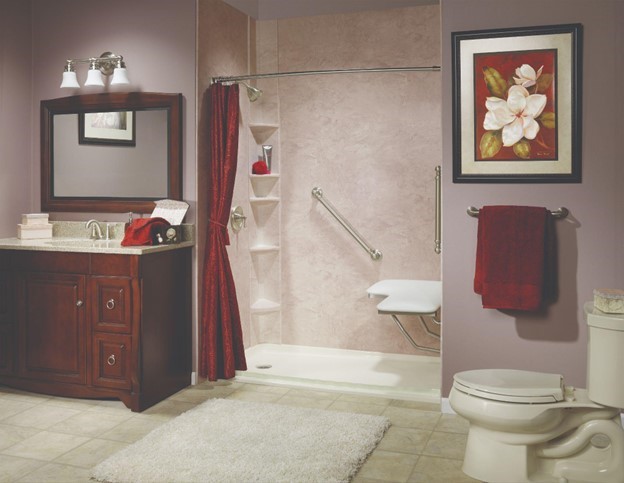
Start Your Shower Remodel with Acrylic from ZINTEX
Now you know all about your options for shower wall materials. We’ve covered everything from cost breakdowns to maintenance requirements and beyond. What’s next?
At ZINTEX Remodeling, we specialize in acrylic showers designed to meet your needs for budget, design, and durability. Our customers choose acrylic because it’s budget-friendly, durable, easy to clean, and increasingly versatile in the design department.
If acrylic feels like the right choice for you, you’re ready to learn more about the ZINTEX shower installation process. Take a look at our 16 steps to success to discover exactly what to expect when you hire ZINTEX.
Subscribe to ZINTEX Remodeling Group's Blog



